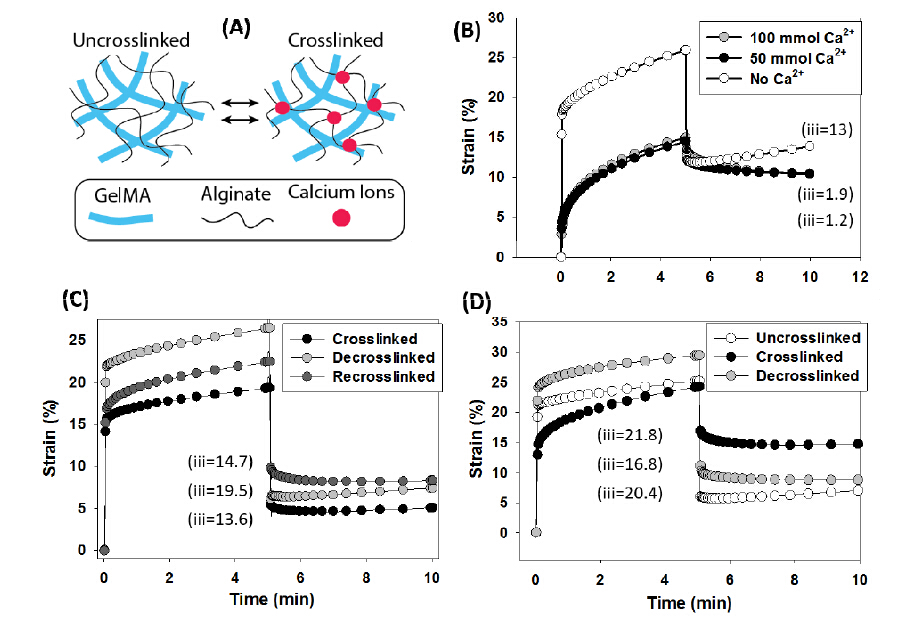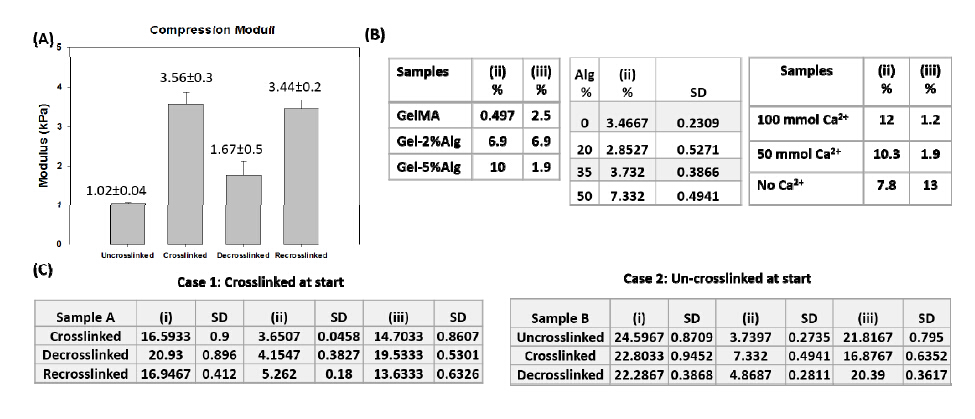1. Introduction
Living cells are inherently dynamic and continuously adapt and remodel their extracellular matrix (ECM) [1]. Since these cell-ECM interactions play a critical role in several biological processes, several biomaterials have been used to mimic the unique properties of native ECM. For the past two decades, synthetic hydrogel biomaterials have emerged as the ideal biomaterial to investigate cell-ECM interaction as it closely resembles the mechanical properties of native ECM as well as its hydrated state facilitates diffusion of essential nutrients [2,3,4]. Synthetic hydrogels such as polyethylene glycol have therefore, been used to answer basic biologic questions about how cells respond to changes in their environment. However, most synthetic hydrogels exhibit linear elasticity which is in contrast to physiological ECM which demonstrates viscoelastic behavior [5,6]. Since natural proteins such as collagen, fibrin, andvarious tissues exhibit stress relaxation and elastic recovery upon application of strain, new hydrogels with tunable viscoelastic properties continue to be developed [7,8,9,10]. For instance, polyampholytes polymers use a combination of strong permanent crosslinks and weak bonds that could reversibly break and re-form, to generate a viscoelastic response [11]. Hyaluronic acid based dual-crosslinking viscoelastic hydrogels have also been demonstrated to improve outcomes of a myocardial infarct in vivo model [12]. Hydrogels exhibiting tunable rates of stress relaxation have also been demonstrate enhanced osteogenic differentiation of mesenchymal stem cells [13]. Natural viscoelastic hydrogels have also been prepared by physically mixing collagen protein and alginate; adding or removing divalent ions have been used to reversibly modify its mechanical properties [14,15,16]. In this work, we present the synthesis and mechanical characterization of a gelatin methacrylate-alginate (Gel-Alg) composite hydrogel, and demonstrate the dynamic control over its viscoelastic property by adding or chelating calcium ions.
2. Materials and Methods
2.1. Gel-Alg Synthesis
GelMA was synthesized using an established protocol [17,18,19,20]. Briefly porcine skin gelatin (Sigma Aldrich) mixed at 10% (w/v) in PBS was added to methacrylic anhydride and dialyzed against distilled water (12-14 kDa cutoff dialysis tubing) for one week at 40 °C to remove the un-reacted groups from the solution. The addition of methacrylamide moieties to the side groups of natural gelatin enables crosslinking via ultraviolet (UV) light. The dialyzed GelMA solution was subsequently lyophilized in a freeze dryer (Labconco) for 1 week. The degree of methacrylation of GelMA was determinedto be 70% [21]. Gel-Alg solution was prepared by first, preparing 10% (w/v) GelMA solution, using deionized water mixed with 0.5% of Irgacure 2595 photoinitiator, and subsequently mixing alginate (5%, w/v) (Sigma Aldrich) in GelMA solution in varying amounts (0, 20, 35 or 50% (v/v)). Gel-Alg solution was pipetted in a Teflon mold between two glass plates, and was exposed to UV light (OmniCure Series 2000 S2000-XLA) with an intensity of 30 W/cm2 and an exposure time of 10 min to obtain a disc-shaped sample (diameter 5 mm, thickness 3 mm). Ionic crosslinking of the alginate component was performed by immersing the samples in 50 mM solution of calcium chloride for 30 min, followed by immersion in DI water for 2 hours to wash away unbound calcium ions. Ionic de-crosslinking was performed by immersing the samples in a 100 mM sodium citrate dihydrate chelator solution, followed by immersion in DI water. All samples were immersed in DI water at 25 °C for 24 hrs before testing their viscoelastic properties.
2.2. Characterization of Compressive and Viscoelastic Properties
A Q800 Dynamic Mechanical Analysis (DMA) was used to test the mechanical properties of Gel-Alg samples. Test samples were placed in the compression clamp of the DMA. A preload force of 10 mN and initial displacement 10 µm was used to obtain a stress-strain plot, and the modulus was determined by calculating the slope from 0 to 5% strain. DMA was also used to perform creep tests (preload of 10 mN, stress of 1 kPa) with force-application and recovery duration of 5 min each. Viscoelastic strain (%) and elastic recovery (%) were calculated from this data (Figure 1A).
3. Results
3.1. Viscoelastic Properties of Gel-Alg Composite
Creep tests were performed on pure GelMA and GelMA-Alginate composite (2% and 5% alginate was used to make a 50/50 Gel-Alg) under 1 kPa stress. Pure GelMA demonstrates 0.49% viscoelastic strain after 5 min of loading, while addition of alginate exhibits a “fluid” like behavior with increased viscoelastic stain (6.9% and 10%) with increased amount of alginate (2% and 5%). Gel-Alg composite with 5% alginate was used to evaluate the effect of varying the volume (%) of GelMA in the composite. Creep behavior was characterized for four ratios of GelMA: Alginate (50:50, 75:35, 80:20 and 100:0) (Figure 1C). The viscoelastic strain of Gel-Alg composite decreases with decreasing amounts of alginate, with the 50:50 ratio exhibiting the highest (7.33%) values of viscoelastic strain. As depicted in Figure 2A, CaCl2 solution was used to ionically crosslink the alginate component of the UV-crosslinked composite. An increase in the concentration of Ca2+ results in minimal change in the viscoelastic strain values, but leads to a large change in the elastic recovery values. The elastic recovery (%) jumps from 1.2% to 13% with the addition of 100 mmol CaCl2 solution (Figure 2B). This composite (50:50 Gel-Alg; 5% (w/v) alginate; 50 mmol CaCl2) was chosen to evaluate the dynamic response of the elastic recovery using addition and removal of calcium ions.
3.2. Dynamic and Reversible Switching of Gel-Alg Composite
Gel-Alg composites were evaluated for their reversible viscoelastic properties using two case studies, with Case 1 starting from the ionically crosslinked state, while Case 2 begins with samples in their ionically un-crosslinked state. Please note that the GelMA component for both cases is crosslinked using UV light, as described in the Methods section. In Case 1, crosslinked samples (using 50 mmol CaCl2) were de-crosslinked using a chelator solution (100 mM sodium citrate), and re-crosslinked using a 50 mmol CaCl2 solution. Creep tests were performed during each stage and initial loading strain, viscoelastic recovery strain, and elastic recovery were obtained (Figure 2C). As expected, the elastic recovery increases from 14.7% to 19.5% after removal of Ca2+ ions, and returns back to a lower value of 13.6% when ions are added back again. In Case 2, un-crosslinked samples were crosslinked using CaCl2 solution, and returns de-crosslinked by using sodium citrate solution. The values of crosslinked and re-crosslinked states are close to each other (Figure 3), but not identical due to sample-to-sample experimental variation. As expected, the elastic recovery decreases from 21.8% to 16.8% after the introduction of Ca2+ ions, and return back to a higher value of 20.4% when Ca2+ ions are chelated. The compressive modulus of crosslinked and de-crosslinked samples were also characterized (Figure 3). The modulus switches from lower values (1.02 kPa and 1.67 kPa) to a higher values (3.56 kPa and 3.44 kPa), when samples are switched between the uncrosslinked and crosslinked states.
4. Discussion
Purely covalently UV-crosslinked GelMA results in a predominantly elastic material, however addition of alginate within GelMA exhibits varying degrees of viscoelasticity depending upon the amount of alginate in the composite. In Gel-Alg, GelMA acts as a stable structural element while alginate acts as the dynamic modifiable element controlled by ionic non-covalent bonding in the presence of calcium divalent ions. Instead of collagen, we choose GelMA, a denatured derivative of collagen, because GelMA possesses acrylate groups, which allow UV-enabled crosslinking of irreversible bonds to ensure the overall structural integrity of the composite samples. In Gel-Alg, the re-crosslinked states exhibit similar viscoelastic properties to the crosslinked state, confirming that crosslinking is reversible and this process is capable of dynamically controlling the elastic recovery. Lastly, crosslinked and re-crosslinked Gel-Alg samples also demonstrate an increase in compression modulus, indicating a change in the elastic property with ionic crosslinking. Taken together, this work reports an easy-to-use method to dynamically and reversibly control the viscoelastic strain and elastic recovery responses ofan ECM-mimicking hydrogel.
5. Conclusion
In this work, we present the synthesis and mechanical characterization of a gelatin methacrylate-alginate (Gel-Alg) composite hydrogel, which has the capability of dynamically modulating the viscoelastic properties by simply adding or chelating calcium ions. This work could potentially guide the development of new hydrogels that could mimic the unique viscoelastic properties of native extracellular matrix.
Acknowledgments
This work was supported by the National Science Foundation (NSF) (CMMI 1634997 and 1547095)
Conflict of Interest
The authors declare that there is no conflict of interest regarding the publication of this manuscript.










 DownLoad:
DownLoad: 







